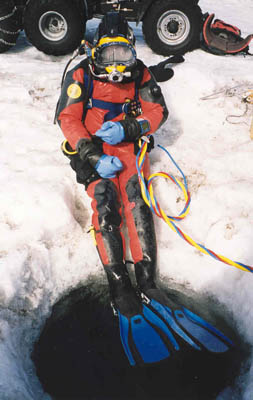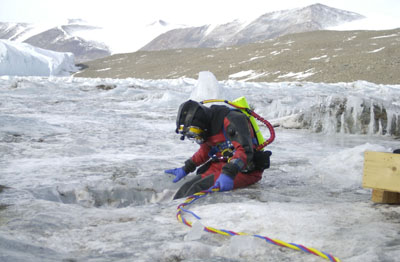Home|Glossary|Links|Journal|Maps
Gearing
Up
But
the divers didn't just want to go to the bottom. They need to be able
to move up and down in the water column, over the topography of the
lake bottom, and in the end, to get back up to the surface. In other
words, they needed to have buoyancy control. Valves on the dry suits
that let the divers pump air into and out of the suits, give them
that.
When
descending, they let air out of their suits to increase their
density. This helped them sink. Conversely, when they wanted to
ascend, they typically pumped air in. But it got trickier near
the surface. As the pressure of the water column above the divers
decreased, the volume of the air expanded. This could have increased
their buoyancy too quickly and caused them to shoot up. So, when
surfacing, the divers actually let air out.
"Ascending slowly - and descending slowly for that matter
- is key", emphasizes Maria. The human body has quite
a few air spaces, such as eardrums, and they need to be equalized
with water pressure to prevent damage. "Good buoyancy
control using the valves is something that dry suit divers practice
constantly", notes Ian.
"After getting all geared
up and standing around for five minutes in multiple superinsulating
layers with a 40-pound vest and a ten-pound helmet on that strains
your neck muscles just to keep your head upright, being in an
icy cold, pretty much weightless environment started to seem
like a good idea", says Maria.
"To enter the lake, divers
sat at the edge of a three- to four-foot diameter hole they
had melted into the ice previously. Since the lake water filled
the hole pretty much up to the surface, the divers could just
lower themselves gently into the water", explains Ian.
|
 Ian
with all his dive gear on
Ian
with all his dive gear on |
"They let a bit of air out
of the suit and slowly sank. To get below the 15 feet of ice in Lake
Hoare typically took a minute or so and to get to the lake bottom
at an average depth of 35 feet took an additional three to five minutes",
says Donna.
"Once on the bottom, it was
important to regulate your movements", notes Ian (more buoyancy
control!).
The benthic mats grow
slowly and are very fragile. Pieces can break off quite easily.

Ian gets ready to drop into the dive hole.
|
|
NATURAL
BUOYANCY CONTROL
In addition to pumping air into and out of their dry
suits, divers can also manage their buoyancy merely
by controlling the way they breathe. "Our lungs
can hold a surprising amount of air" explains
Donna.
"If you're underwater and inhale deeply you
will increase your buoyancy and will rise. If you make
your exhalations longer and more frequent, you'll decrease
the volume of air in your lungs and will sink. No arm
flapping or swim strokes are needed".
" Try it in a swimming pool sometime"
suggests Ian "the
shallow end" he notes!
|
|
Photos courtesy of Karen Cozzetto.
May not be used outside this website without her express permission.
Next >>


